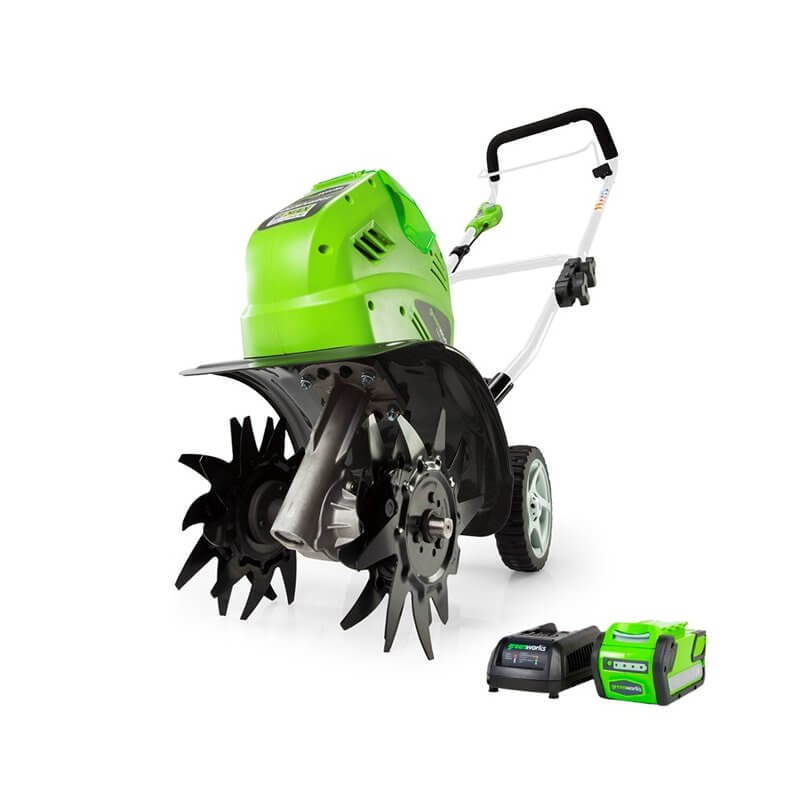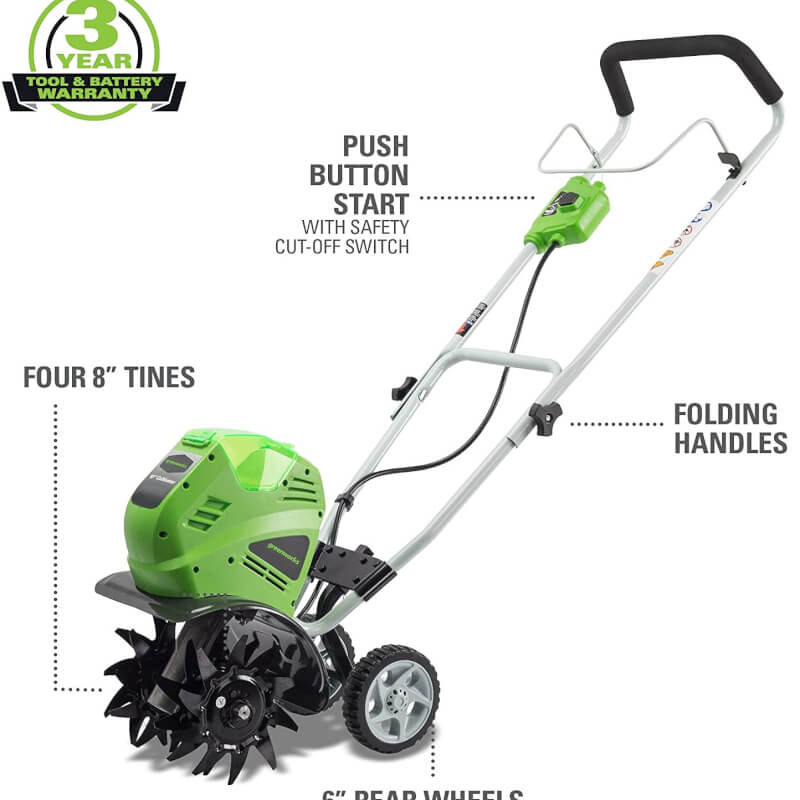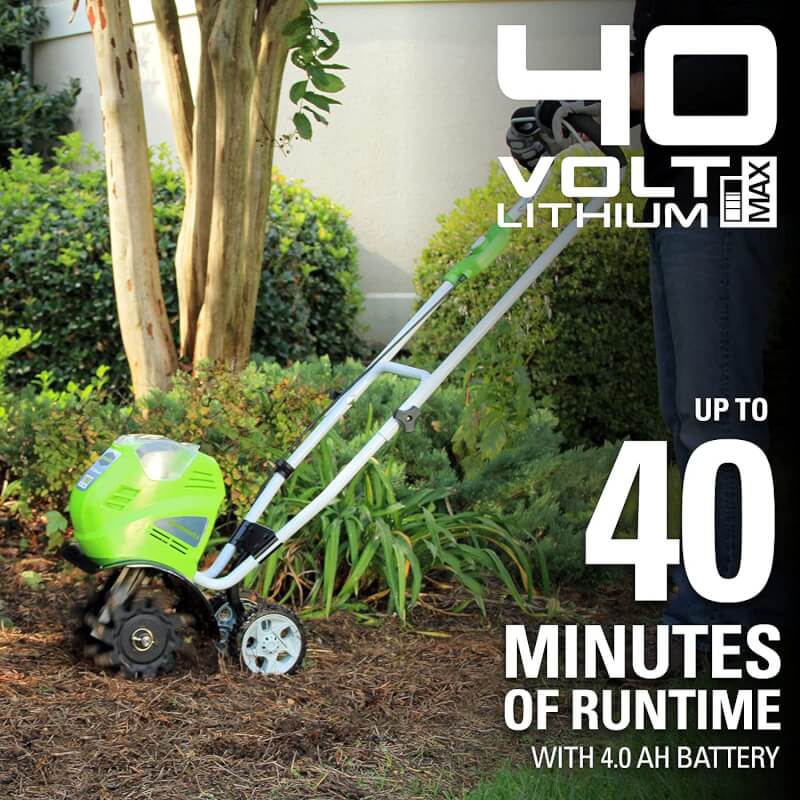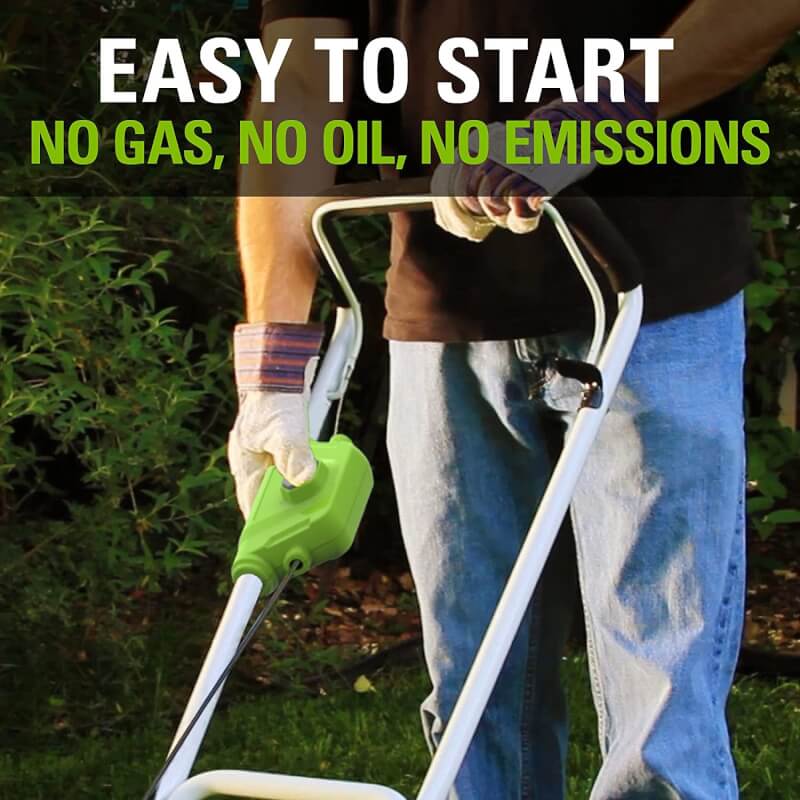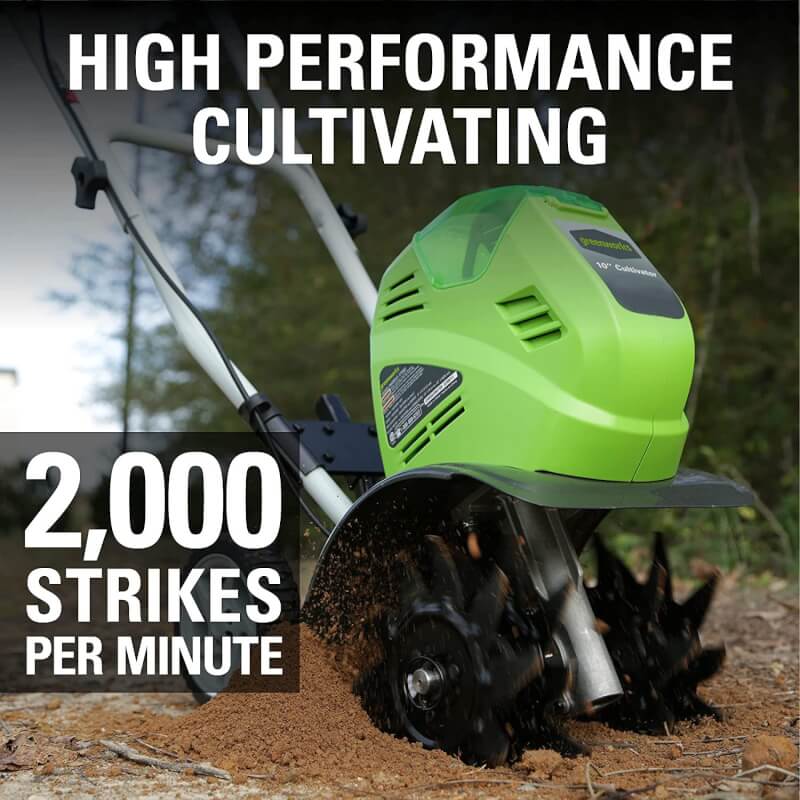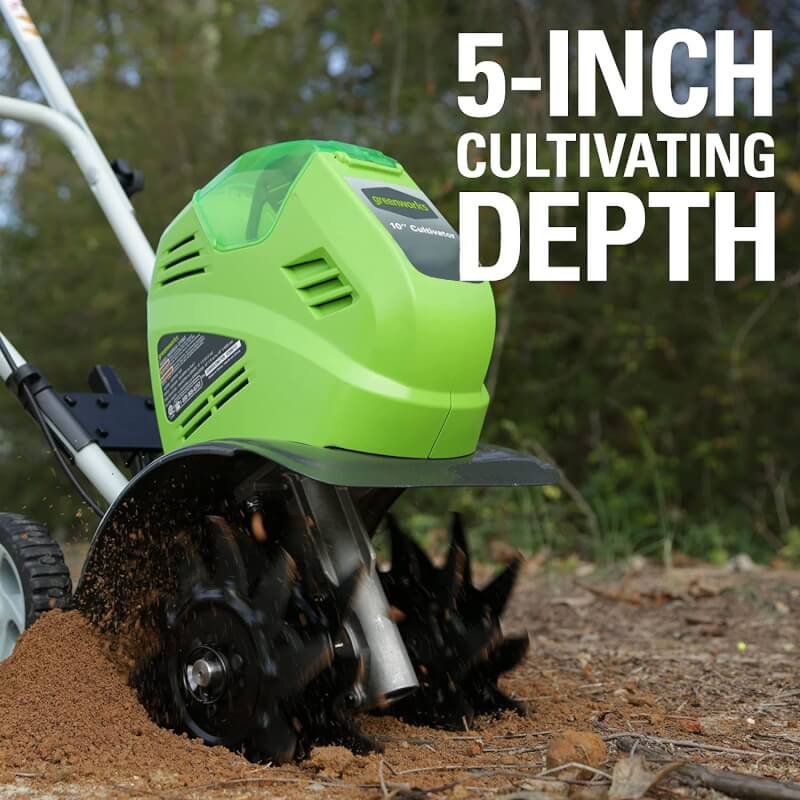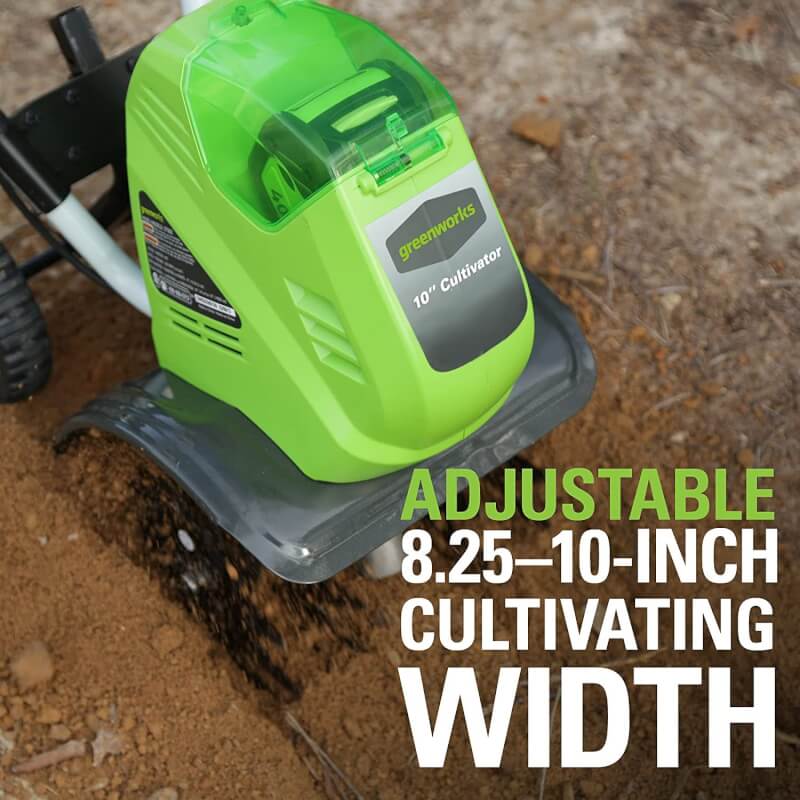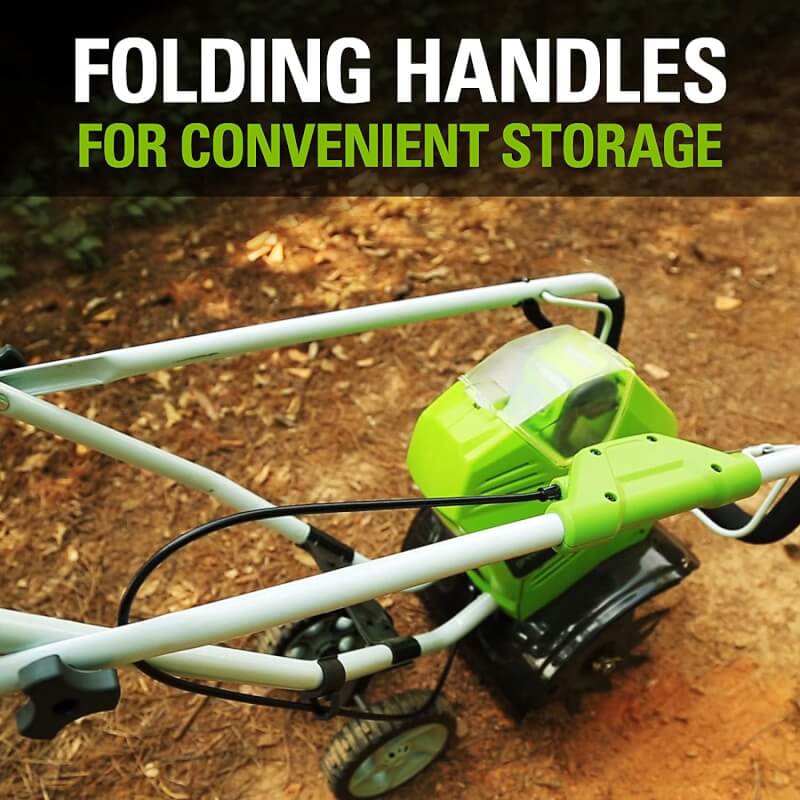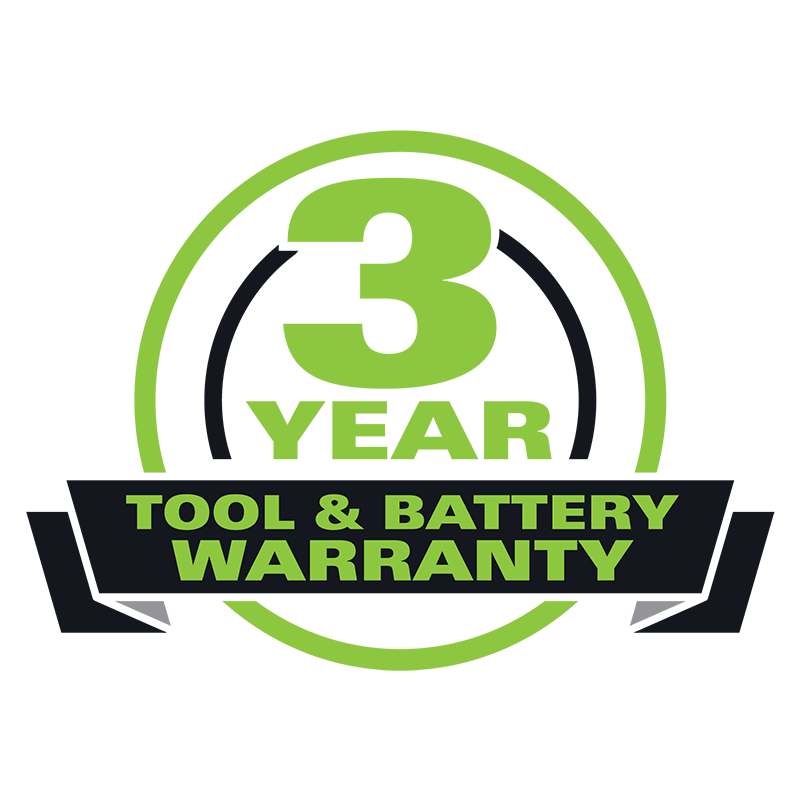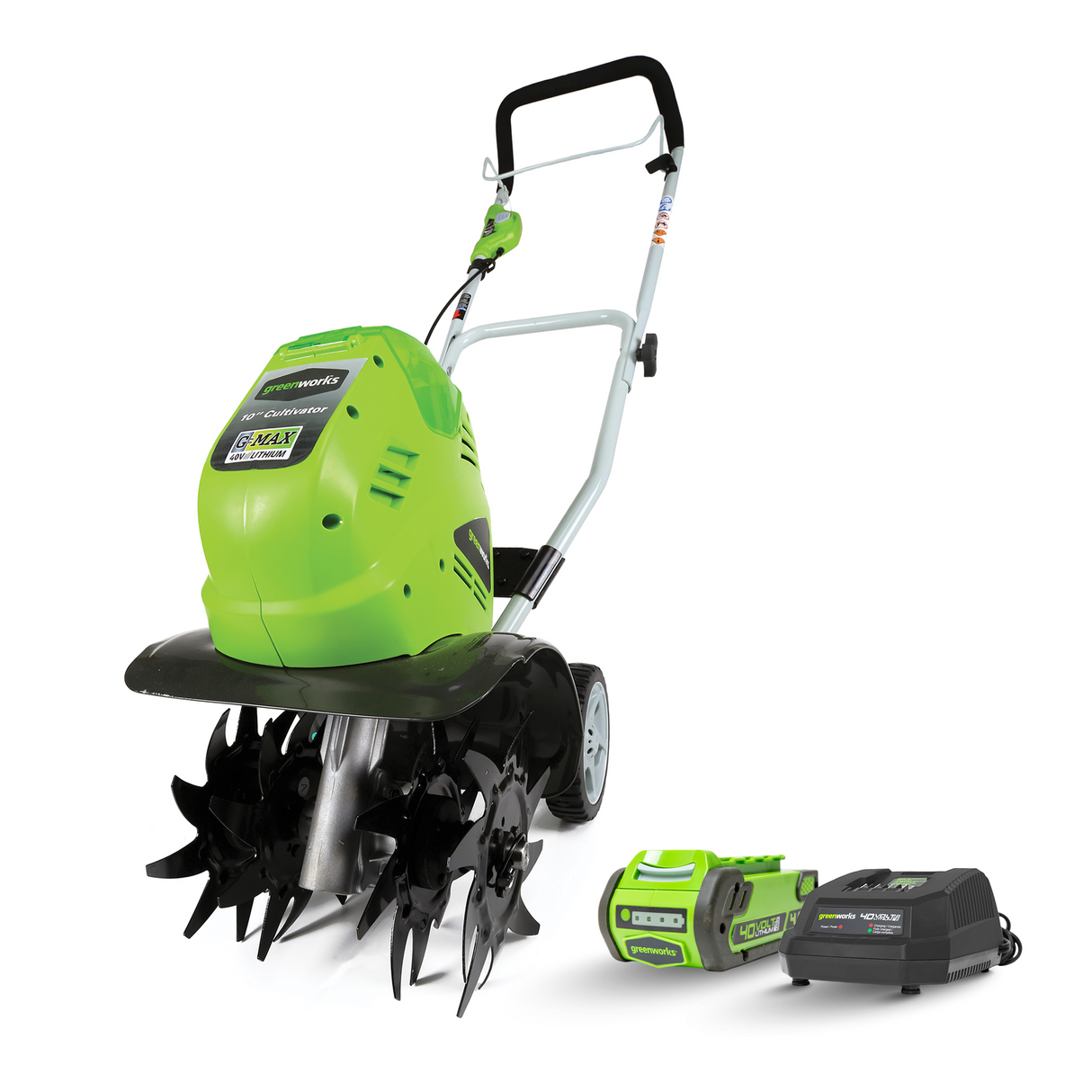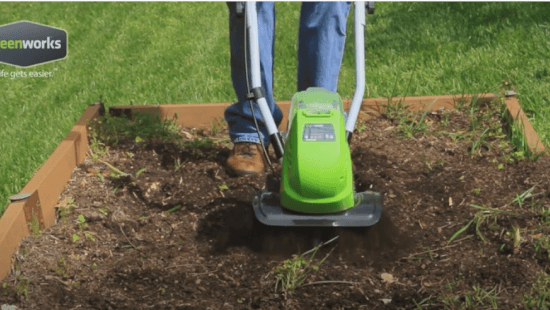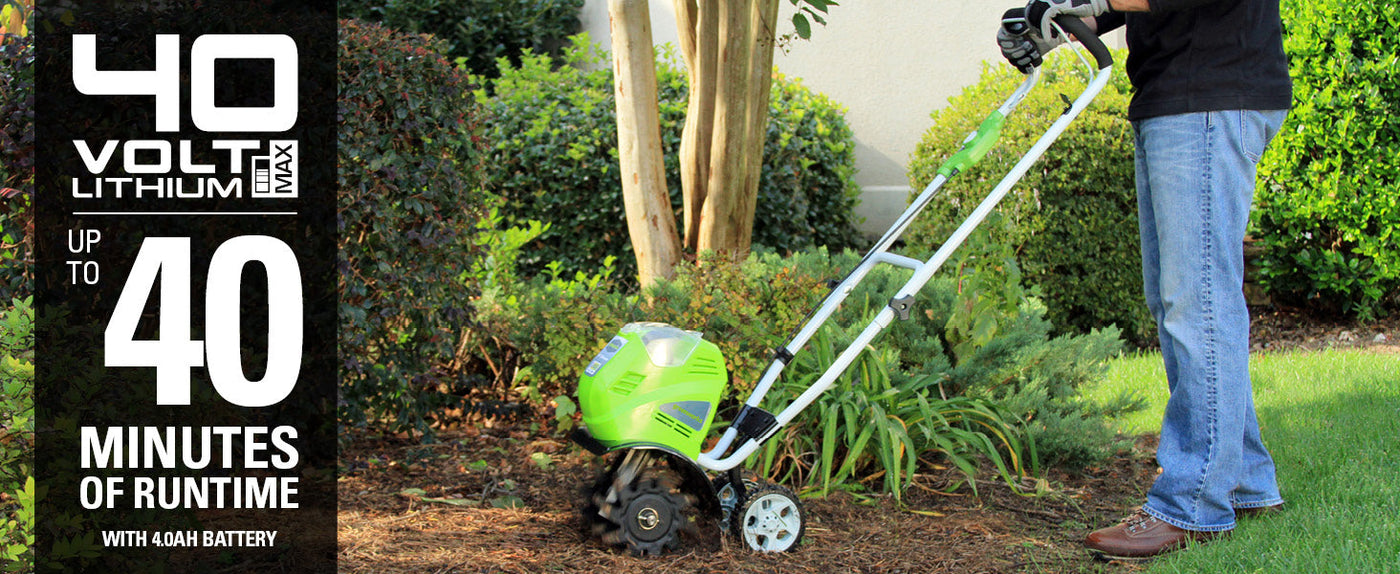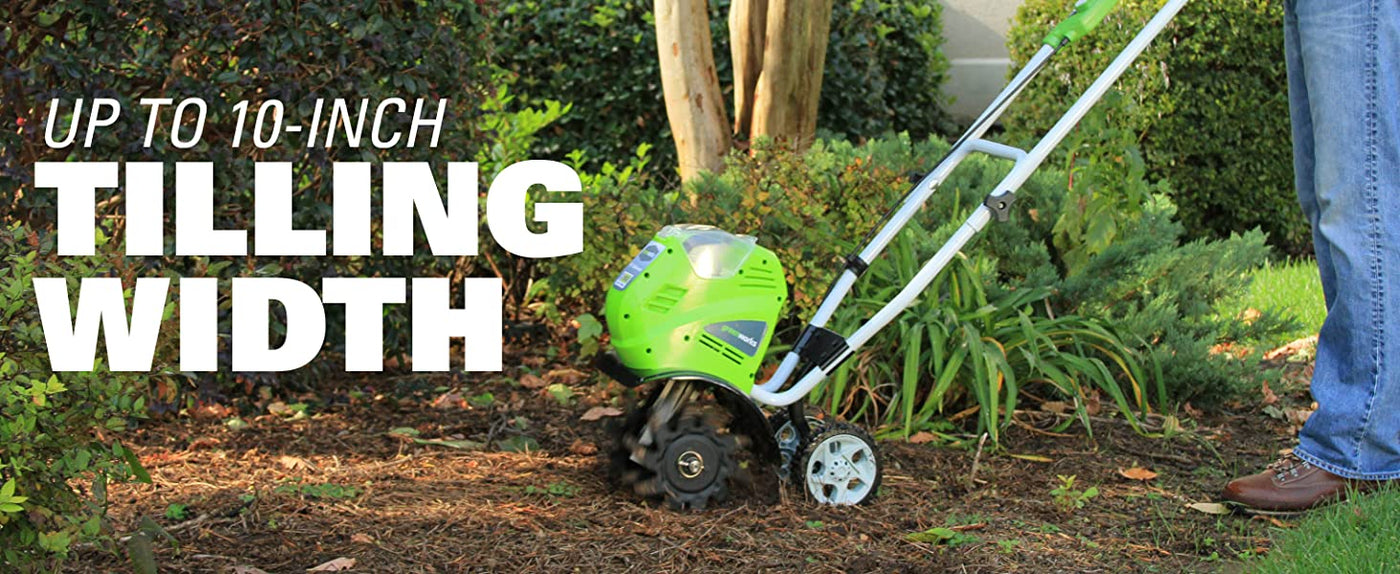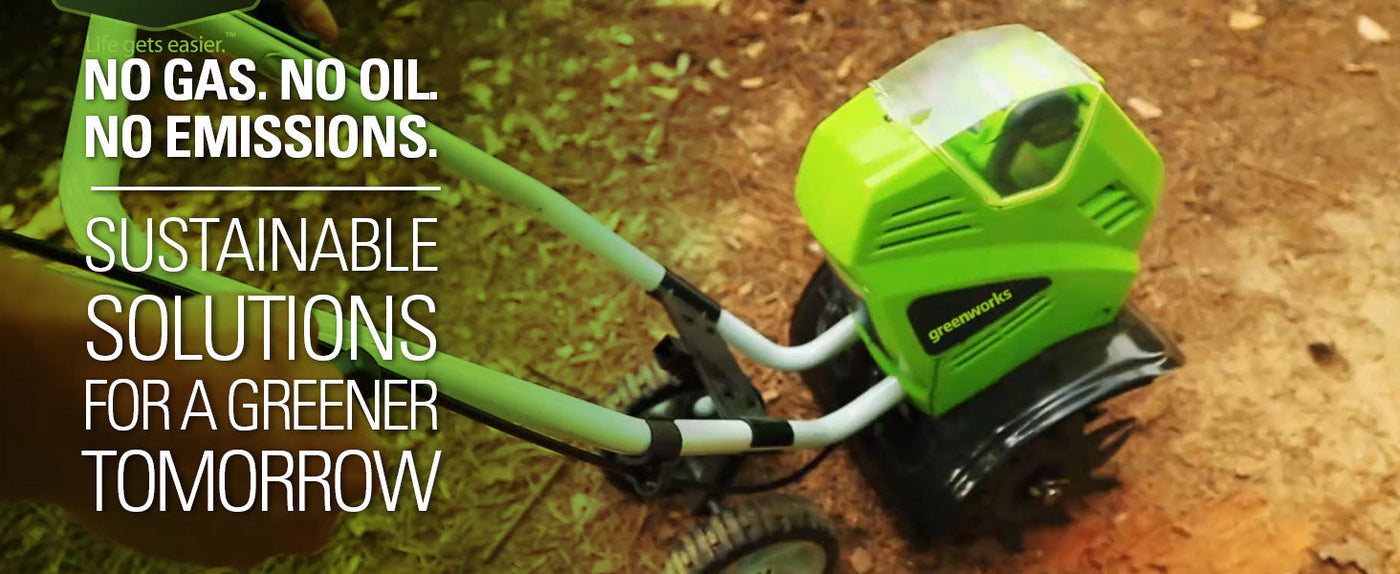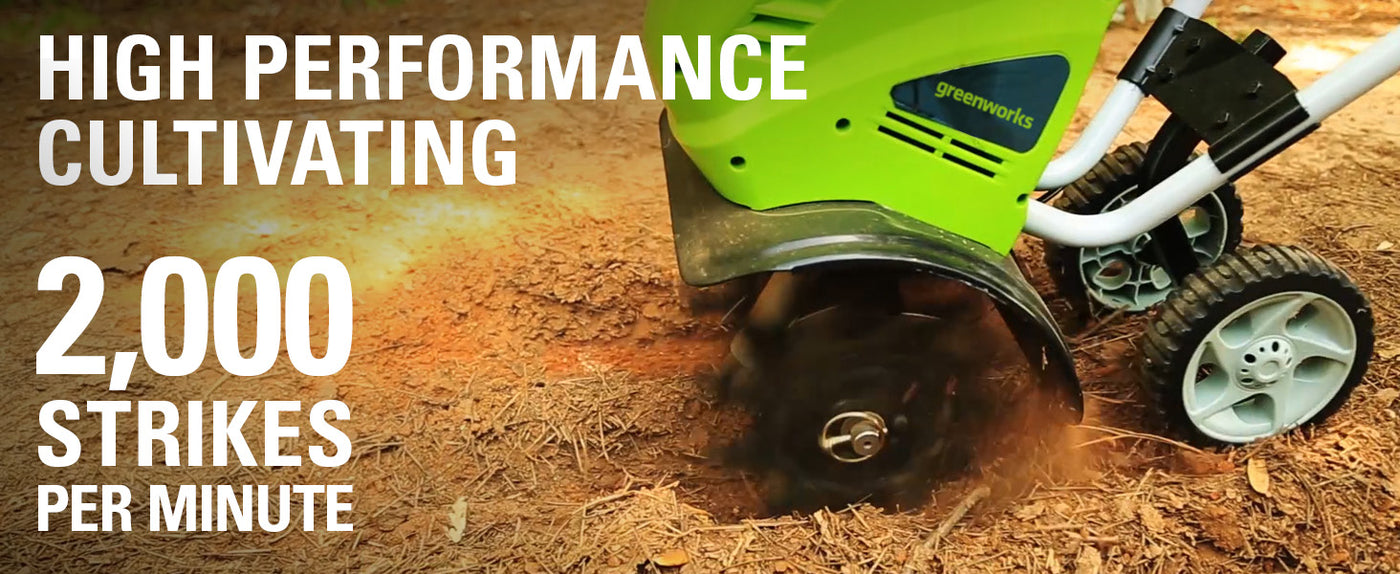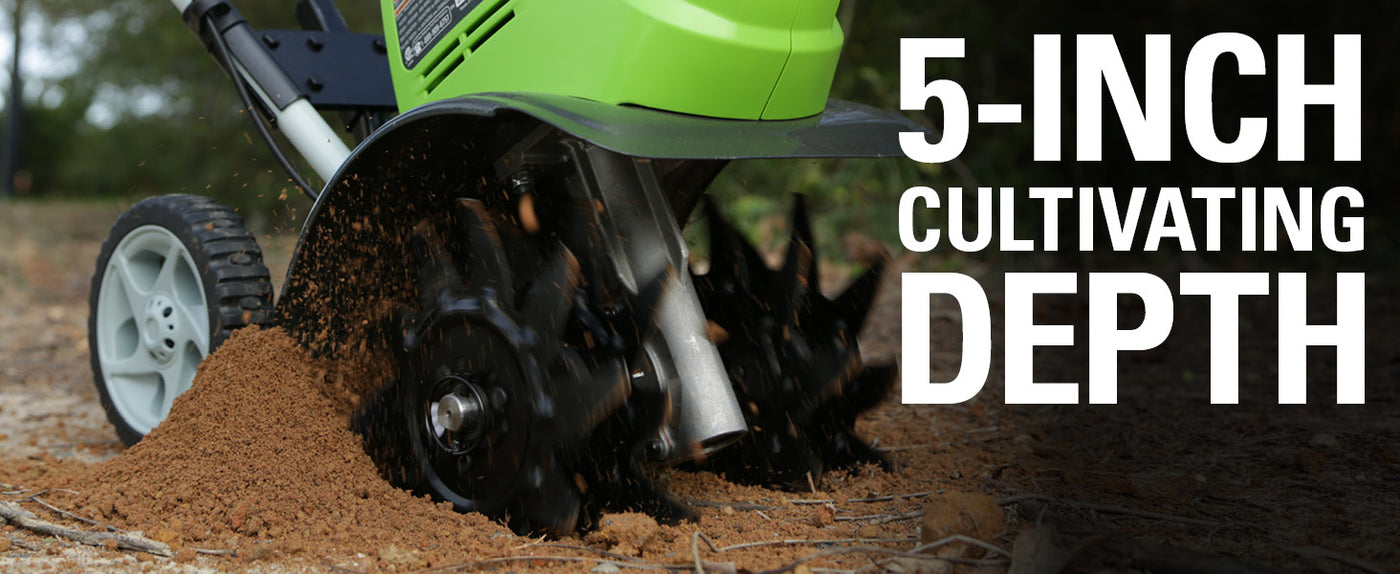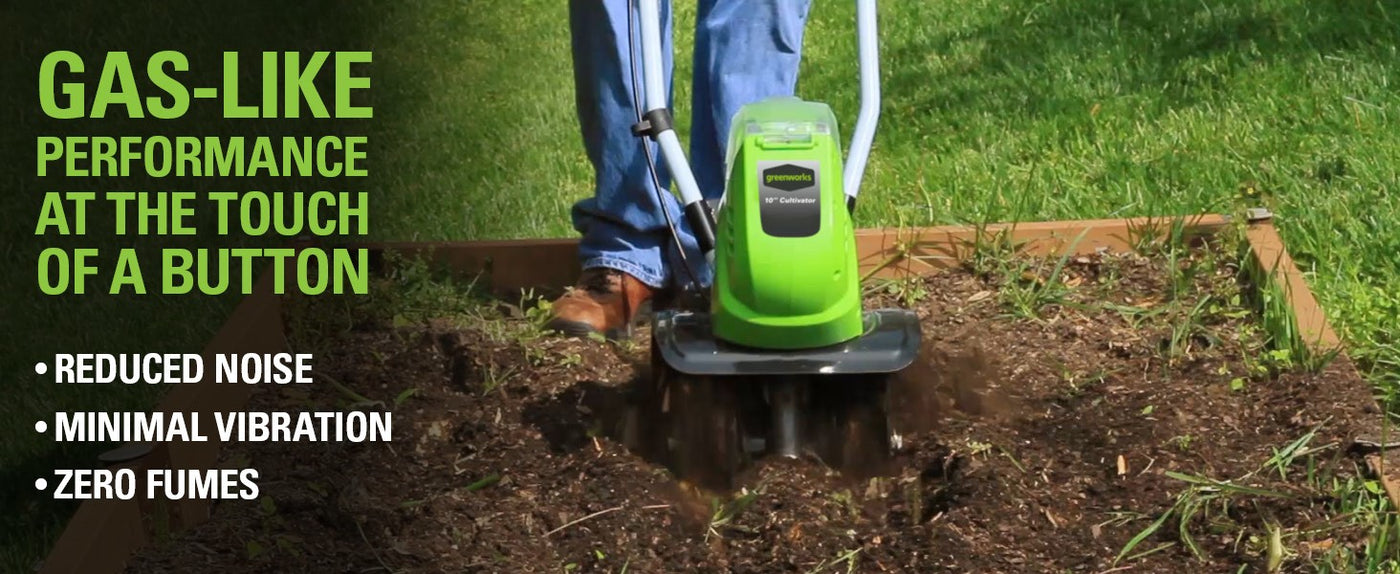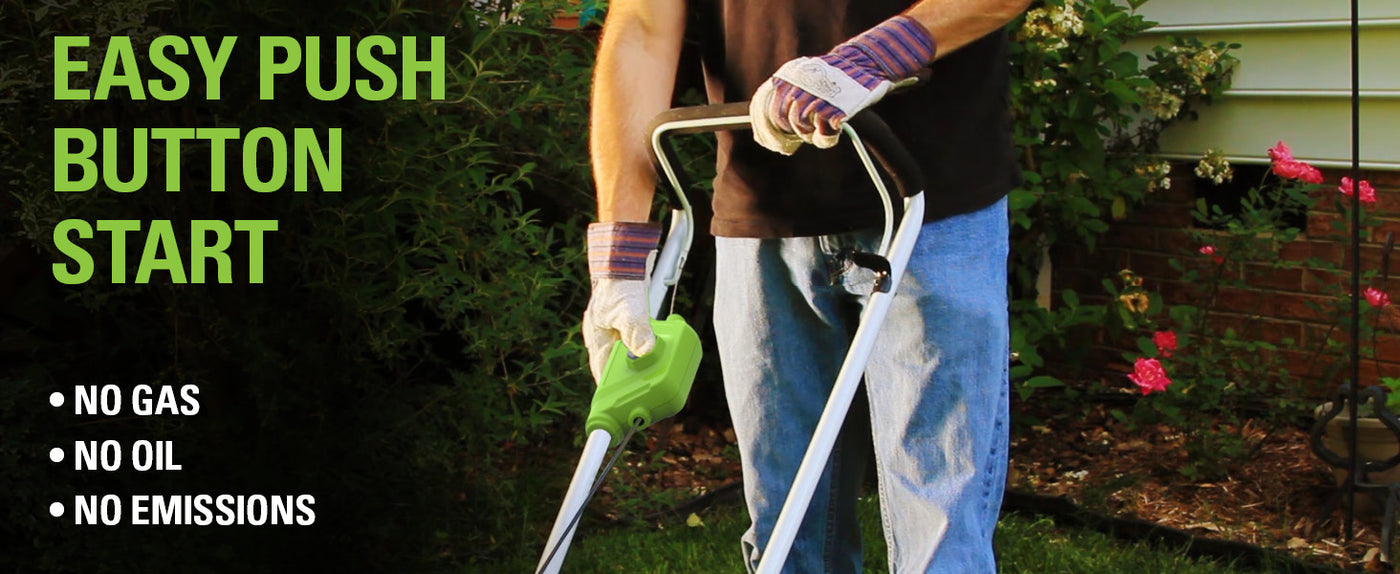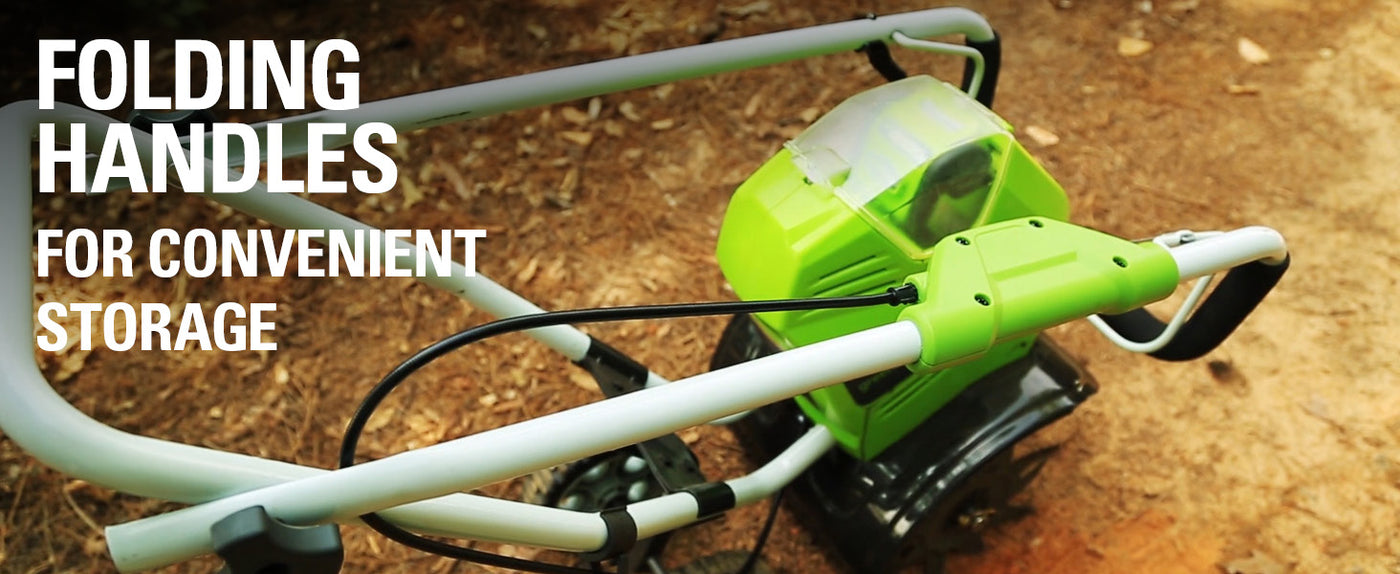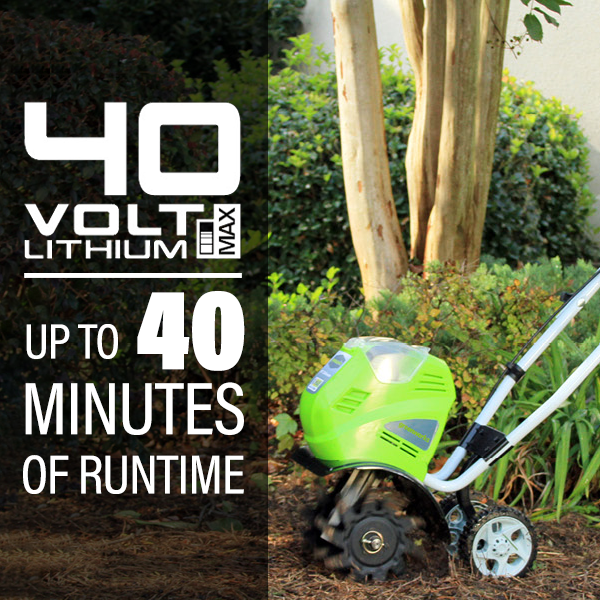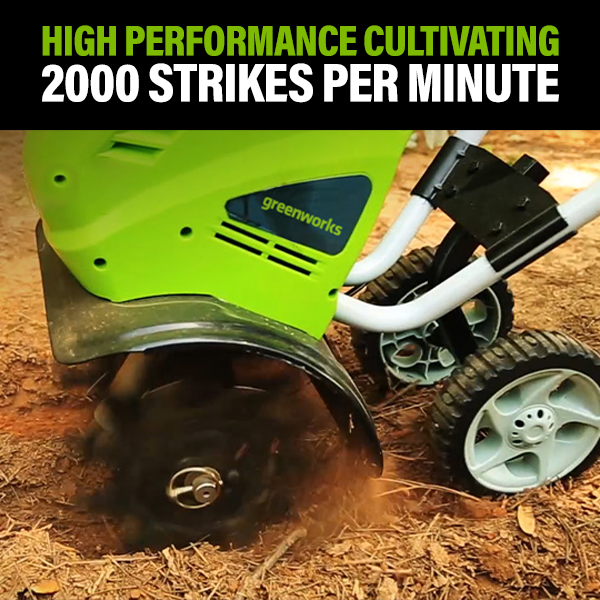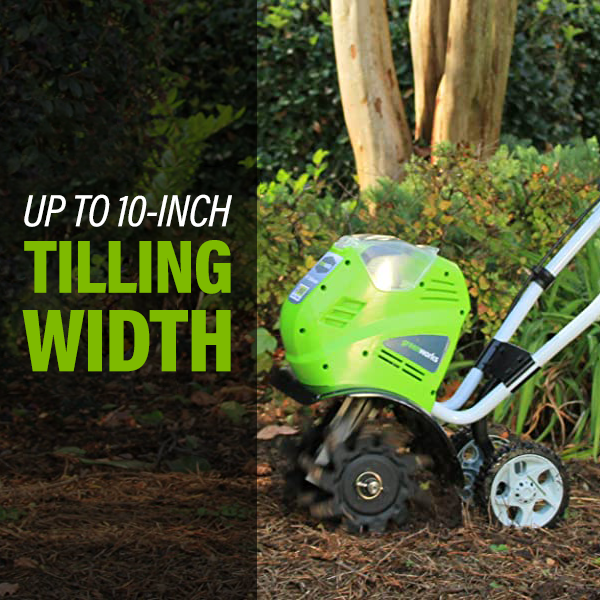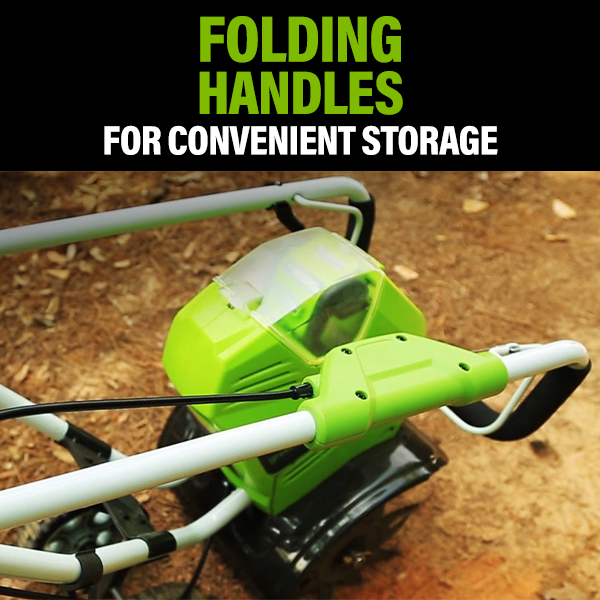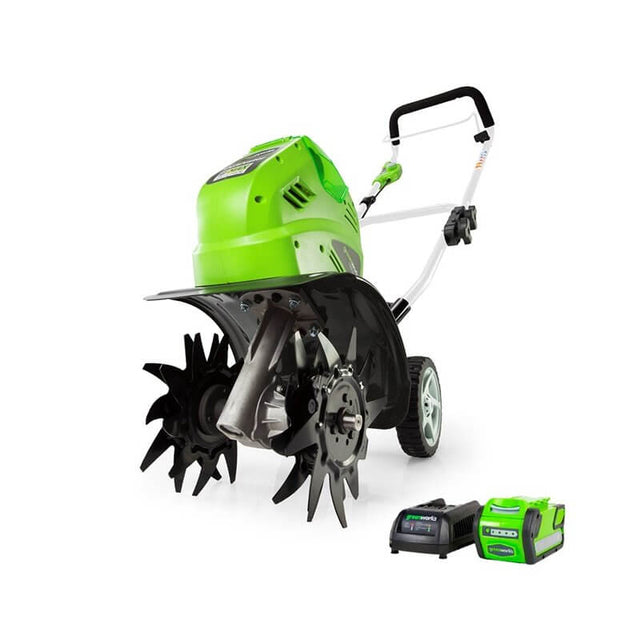40V 10" Cultivator, 4.0Ah Battery and Charger Included
40V 10" Cultivator, 4.0Ah Battery and Charger Included is backordered and will ship as soon as it is back in stock.
Warranty
Warranty

Compatible With :
Description
Description
Greenworks 40V cordless outdoor power equipment is ideal for homeowners who are simplifying and focusing on what is essential to getting the most out of life. The Greenworks 40V family of tools are built with medium weight construction and high-efficiency brushless motors. The universal 40V battery system powers more than 25 products and provides gas-like performance, giving you all the power you need to tackle your yard. Kick gas to the curb and go green!
Specifications
Specifications
-
Voltage40V
-
Amp Hours4Ah
-
Weight39.24 lbs.
-
Size15.2" × 33.5" × 15.8"
-
Wheel Size6 in
-
Tilling Width10 in
-
Tilling Depth5 in
-
Charge Time to 100%from 120 mins
-
Runtimeup to 40 mins
-
MotorBrushed Motor
-
No Load Speed200 RPM
-
Weight (with Battery)29.3 lb. (13.3 kg)
-
Sound Level85 dB(A)
-
Warranty3-Year Warranty
-
40V 4.0Ah Lithium-ion Battery
-
Voltage40V
-
Amp Hours4Ah
-
Weight3.02 lbs.
-
Size3.7" × 4" × 7.1"
-
Watt Hours144
-
Charge Time to 100%from 120 mins
-
Life CyclesUp to 2000
-
Warranty3-Year Warranty
-
40V Charger
-
Voltage40V
-
Weight2 lbs.
-
Size6.5" × 8.3" × 3.7"
-
Charge Time to 100%from 120 mins
-
Charge Time (2.0 AH Battery)from 60 mins
-
Charge Time (4.0 AH Battery)from 120 mins
-
Warranty3-Year Warranty
Manuals
Manuals
-
Download:
Product Videos
Frequently Asked Questions
Frequently Asked Questions
- Would this cultivator cut through small mesh-like roots under a tree? I’ve been told light weight cultivators like this only bounce along on rough ground.
- How deep will it dig into topsoil?
- Do the tines rotate backward?
- Can I use my cultivator to remove weeds?
- What is the best/ideal season to use my cultivator?
- Can the cultivator break up small twigs and branches?
- Can it cut through tree root?
- Can I use my cultivator as an edger? Can I remove the tines and use as an edger?
- Can it be left out in the rain?
- Are the tines bent?
- How do you lubricate the gear box and what type of lubricant do you use?
- Can I leave my battery in the charger after charging it?
- Why do batteries cost so much more than the tool?
- How do I store the battery? Can I leave the battery in the garage or shed?
- My battery is stuck in my tool. How do I get it out?
- How do I check the charge on my battery?
- Can I use any Greenworks battery in any Greenworks tool?
- Are there certain tools that can’t accept all same voltage batteries?
- Do all batteries of the same voltage use the same charger?
- Does battery temperature matter?
- The charger indicates that my battery is fully charged but I was just using it and it depleted. Why isn’t it charging?
- My charger is flashing red when I engage my battery. Why is this happening?
- My charger has a solid red light on it when I engage my battery. What is happening?
- Are your chargers made for 220V or 120V outlets?
It will be able to tear up small roots, however, this unit is not designed for tree roots. We advise that you avoid roots and rocks when using this cultivator. It works best for tilling soil.
Depending on soil conditions the cultivator will go down to a depth of 5 inches. We do advise the removal of rocks and roots before cultivating to prevent damage to the unit.
Tines do not rotate backwards.
Removing weeds with a cultivator is generally not recommended. While it makes the job a lot faster, it can also spread the seeds underground, ensuring the quick return of weeds into your garden.
Autumn and spring are the most favorable seasons to get your cultivator out of the shed. Avoid using it if the land is too soggy as this could result in compact clods when the soil dries. For best results, wait a day or two after the rain until the soil is semidry.
It might be able to handle small twigs under 1 inch in diameter, but it's designed to cultivate soil for small gardening projects like flower beds.
It will not cut through tree root. Tree roots should be avoided when operating this unit as it will cause damage.
Even when reducing number of tines, it is not ideal for edging as the tines are designed specifically to dig into soil for tilling rather than simply cutting blades of grass. You can remove the tines for smaller areas for tilling, but it would not make it suitable for edging.
As this is an electric unit, it cannot be left out in the rain. It is advised to store this unit in an upright position in a clean, dry place.
Yes, the tines are bent to help cultivate the soil further while in use.
The gearbox is full of synthetic transmission grease and should never really need to be replaced. However, if you wish to change out the grease, you will need to remove the gearbox from the unit (4 bolts at the connection point). This will leave to transmission exposed and lubricant can be added by hand.
The battery chargers do have auto cut offs to prevent it from over charging. However, we do advise customers to remove the battery from the charger after it has been fully charged and to also unplug the charger from the outlet, as this is good electrical safety practice to do so. This will also help to prevent false defect readings and allows the charger to reset itself each time it’s used to charge a battery.
The battery is the most important component for a battery-operated unit. Please be assured we price our batteries with the cost of material, manufacturing, and current market pricing in mind. Batteries are the costliest items to manufacture and ship in any kit. Full kits including a tool, battery, and charger are priced affordably so that consumers can begin building that line of tools and move forward purchasing tool-only units. When you purchase batteries on their own, it is more notable the cost that they carry.
When the battery is not in use, we suggest storing it indoors, in a cool dry area - away from direct sunlight. Leave the charger unplugged and the battery disconnected from the charger unless it needs charging. It is recommended to store the battery with a full charge, and if it is being stored for a period where no use is expected, to check on the charge every couple of months. If you notice the charge has dropped, we advise charging the battery back up to full before returning it to its safe storage place. Following these steps will ensure you receive the most out of the battery life.
60V/ 80V Products: To remove the battery, push and hold the battery release button. Then, pull the battery pack straight out. In some cases, if the springs underneath have gotten locked down you might have to give a small push to the top of the battery to re-engage them to help the battery pop up. The battery pack fits snugly into the product to prevent accidental dislodging while in use; it may require a strong pull to remove. Before use, be sure that the rails on the battery and product are free of debris that could cause the battery to get stuck. 24V/ 40V Products: To remove the battery, press the latch button on the battery pack down and hold. Pull the battery pack out of the handle. The battery pack fits snugly into the product to prevent accidental dislodging while in use; it may require a strong pull to remove. Before use, be sure that the rails on the battery and product are free of debris that could cause the battery to get stuck.
Press the battery capacity indicator (BCI) button located at the end of the battery. The lights will illuminate according to the battery capacity level. Please note this switch does require a firm direct push using the tip of your finger. If the button is not being fully engaged, the lights will not activate. Please also be advised the lights only stay on for a few seconds and will automatically turn off. Another reason the lights will not power on is if the battery is completely depleted of power and needs to be charged.
Our batteries are interchangeable with tools that are of the same voltage platform only. The difference between batteries of the same voltage is the ampere-hour (Ah) rating. The higher the ampere-hour (Ah) rating on the battery is the more run time it has to offer.
There are a few exceptions. • Our 80V 20” snow thrower models 2600402 / 2605202 / 2601302 manufactured prior to September of 2017 can only use 2.0Ah or 2.5Ah battery models. • Our 60V 8.0Ah battery model 2957102 cannot be used in the following tools due to the height: dual-port lawnmowers, pressure washers, or the wet/dry vacuum.
Yes, they do. Each product line has designated charger models that can charge all batteries in that voltage platform, no matter the Ah rating.
The temperature of the battery prior to use should not be too warm or too cold. For snow throwers if the battery is too cold it may not be operatable. Allow the battery to get to room temperature prior to use. For our other tools allow the battery to cool down prior to use if it’s too warm. To avoid battery temperature issues, batteries should be stored indoors in a dry and cool location. Information on battery storage and temperature will in inside your owner’s manual.
Putting a battery that was just in use onto the charger often results in a false full charge signal. Remove the battery from the charger and allow it to rest in a room temperature area for approximately 10-15 minutes before charging.
When the battery is inserted into the charger and the status LED blinks red, remove the battery from the charger for 1 minute, then reinsert. If the status LED blinks green, then the battery is properly charging. If the status LED is still blinking red, remove the battery and unplug the charger for 1 minute. After 1 minute, plug in the charger and reinsert the battery. If the status LED blinks green, then the battery is properly charging. If the status LED is still blinking red, then this likely indicates an issue with the battery or charger and should be taken care of either with our warranty team or by means of replacement.
This typically indicates that the battery is at the wrong temperature to be charged. Allow the battery and charger to rest indoors at room temperature until they are no longer hot/cold and attempt charging again.
Greenworks chargers sold in the USA and Canada are designed for use on 120V outlets only.

